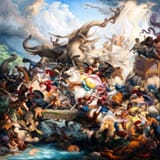Search Results
7/24/2025, 12:50:53 AM
"Hannah Belle Leading Her Forces at the Battle of Trebbia"
Description:
"My two paintings, illustrating the military triumphs of Hannah Belle Barca, are explorations of our stylistic gender biases. In these works, I am transitioning the historical figure Hannibal Barca (the Carthaginian general who crossed the Alps with elephants and spent years rampaging through Roman territory) from male to female. By transitioning the general’s gender (and that of much of her army), I am reflecting the ascendancy of historical fiction that reimagine the past to reflect recent evolutions in gender and racial realities such as Bridgerton, and also the proliferation of women superheroes like Wonder Woman. In addition to transitioning the gender of the general and her army, I am also transitioning the aesthetic conventions of these scenes to one that is intentionally decorative and feminine, with pastel colors, and curlicue compositions. Battle scenes in Western art history are usually “serious” (synonymous with masculinity for most of our culture’s history since the Renaissance) and signified as such by muted color and dramatic, high contrast lighting (think of the muted color palette of the movie Dunkirk, the black and white cinematography of Shindler’s List or Goya’s Disasters of War series). By contrast, the colors and compositions for the Hannah Belle paintings are a cross between a Fragonard and a riot at a Coachella concert. The work dares the viewer to dismiss its content because of the bias against the aesthetics of femininity as constructed by pop culture divas like Taylor Swift, Megan the Stallion, and similar artists."
Description:
"My two paintings, illustrating the military triumphs of Hannah Belle Barca, are explorations of our stylistic gender biases. In these works, I am transitioning the historical figure Hannibal Barca (the Carthaginian general who crossed the Alps with elephants and spent years rampaging through Roman territory) from male to female. By transitioning the general’s gender (and that of much of her army), I am reflecting the ascendancy of historical fiction that reimagine the past to reflect recent evolutions in gender and racial realities such as Bridgerton, and also the proliferation of women superheroes like Wonder Woman. In addition to transitioning the gender of the general and her army, I am also transitioning the aesthetic conventions of these scenes to one that is intentionally decorative and feminine, with pastel colors, and curlicue compositions. Battle scenes in Western art history are usually “serious” (synonymous with masculinity for most of our culture’s history since the Renaissance) and signified as such by muted color and dramatic, high contrast lighting (think of the muted color palette of the movie Dunkirk, the black and white cinematography of Shindler’s List or Goya’s Disasters of War series). By contrast, the colors and compositions for the Hannah Belle paintings are a cross between a Fragonard and a riot at a Coachella concert. The work dares the viewer to dismiss its content because of the bias against the aesthetics of femininity as constructed by pop culture divas like Taylor Swift, Megan the Stallion, and similar artists."
Page 1
